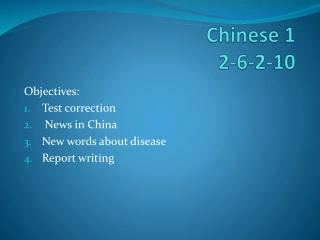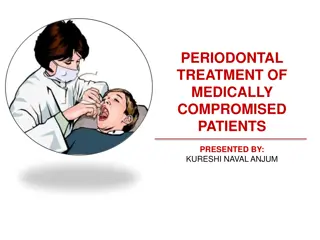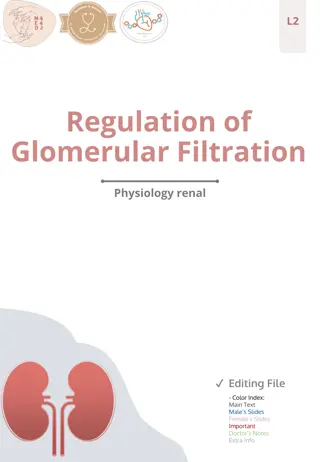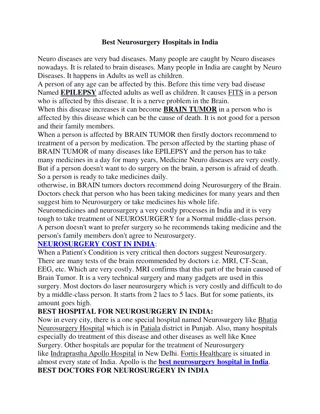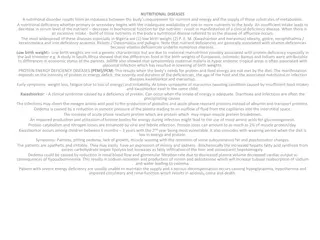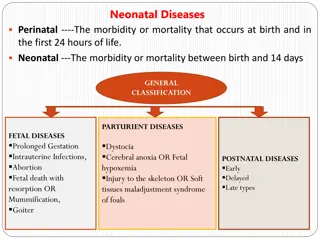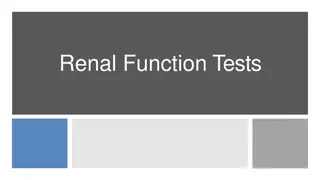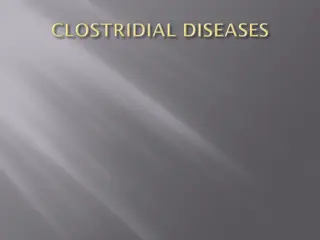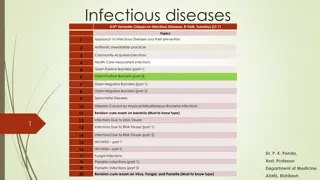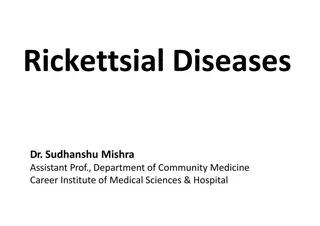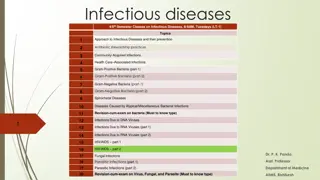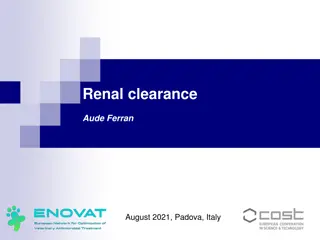
Glomerular Diseases: Clinical Presentations and Diagnostic Strategies
Explore the clinical presentations of glomerular diseases, ranging from asymptomatic proteinuria to acute kidney injury. Learn about evaluating proteinuria and the significance of albumin, microalbumin, and protein levels in diagnosing glomerular disorders. Understand the classification of proteinuria severity to guide treatment decisions effectively.
Download Presentation

Please find below an Image/Link to download the presentation.
The content on the website is provided AS IS for your information and personal use only. It may not be sold, licensed, or shared on other websites without obtaining consent from the author. If you encounter any issues during the download, it is possible that the publisher has removed the file from their server.
You are allowed to download the files provided on this website for personal or commercial use, subject to the condition that they are used lawfully. All files are the property of their respective owners.
The content on the website is provided AS IS for your information and personal use only. It may not be sold, licensed, or shared on other websites without obtaining consent from the author.
E N D
Presentation Transcript
Glomerular Diseases Brian Cronin, MD, FASN, FACP March 17 2025
Disclosure: Several questions modified from ASN Nephrology Quiz and Questionnaire KSAP
Clinical Presentations of Glomerular Disease Asymptomatic Proteinuria Nephrotic Syndrome Asymptomatic Hematuria Progressive CKD Acute Kidney Injury (RPGN)
Case 1 19 yo woman with no PMH referred for proteinuria found on UA at routine gynecology appointment. No associated symptoms, no edema, hematuria or foamy urine. Consumes a vegan diet. BP 110/70 exam no edema and otherwise unremarkable. UA: SG 1.008, pH 8.2, leukocyte negative, nitrites negative, blood negative, protein 2+, glucose negative, ketones negative How do you evaluate?
Urine Albumin Creatinine Ratio (UACR) 12 mg/gram Urine Protein Creatinine Ratio (UPCR) Urinalysis: Checks for albumin False Positive: Alkaline Urine (pH > 8.0), Concentrated Urine (High SG > 1.025), IV contrast, chlorhexidine False Negative: Acidic pH, Dilute Urine (Low SG), Non albumin protein
Albumin, Microalbumin, Protein Whats the difference? Most urinary protein is albumin In glomerular diseases urinary albumin is 55-60% of the total urinary protein If the percentage is low (urinary albumin < 40% of the total urinary protein) think tubulointerstitial disease If the percentage is very low (urinary albumin < 20% of the total urinary protein) think Bence Jones proteinuria (myeloma)
How do we classify the severity of proteinuria? Microalbuminuria Albumin Creatinine ratio: 30- 300 microgram/ mg (or milligram/gram its the same thing) Equivalent protein creatinine ratio: 150 500 milligram/gram Overt Proteinuria Albumin Creatinine ratio: > 300 microgram/ mg (or milligram/gram its the same thing) Equivalent protein creatinine ratio: > 500 milligram/gram Nephrotic Range Proteinuria More than 3.5 grams / 24 hrs Protein Creatinine ratio > 3500 mg/g, Albumin creatinine ratio >2200 mcg/mg. This is an assumption.
Ratio or 24 Hour Urine? Nephrotic proteinuria is more than 3.5 grams per 24 hours, but all I see are protein creatinine ratios and they ran out of those orange jugs. Help! Assumption: If the patient peed in the jug for 24 hours there would be 1 gram of creatinine. The protein creatinine ratio is reported in milligrams per gram. Using this assumption the ratio (number of milligrams per gram), roughly equals the mg of protein there would be if the patient did a 24 hour urine. This assumption is not true because the amount of creatinine in a 24 hour urine depends on muscle mass (an elderly woman may have less 1 gram and a younger muscular man will have more). We use this assumption anyway to rate the severity of proteinuria.
Case 2 68 year old woman noticed bilateral lower extremity edema one month ago. No other symptoms (no fever, anorexia, weight loss, night sweats, rash, joint pain or change in urine color). Medications: Fish oil, acetaminophen. Exam: Normal BP, 1+ pitting edema bilateral lower extremities Creatinine 0.7 g/dl Urinalysis 3+ protein, negative blood Renal US: Unremarkable including negative for renal vein thrombosis How do you evaluate?
Albumin 2.6 g/dl Total Cholesterol 350 mg/dl 24 hour urine protein 10 grams/ day
Nephrotic Syndrome The differential for nephrotic proteinuria may seem overwhelming, but it is manageable if you can remember 7 (five + two) things: Five primary glomerular pathologies: Minimal Change Disease (MCD) Focal Segmental Glomerulosclerosis (FSGS) Membranous Nephropathy (MN) IgA Nephropathy Membranoproliferative Glomerulonephritis (MPGN) Two systemic diseases: Diabetes Amyloidosis
Minimal Change Disease Occurs in young people. Most common cause of nephrotic syndrome in children. For this reason, children with nephrotic syndrome often don t get a kidney biopsy. They assume this is the diagnosis and only biopsy if they don t respond to treatment. Can happen in adults too. About 10% of minimal change disease is in adults. Usually relatively young adults (average age 45). Abrupt onset (days - weeks) of full blown nephrotic syndrome. That is edema, hypoalbuminemia and severe proteinuria. The proteinuria and hypoalbuminemia are relatively severe (i.e. 10 grams protein and albumin < 2.5 g/dl). There can be associated AKI (in 25-35% of cases). This is not a nephritic or Rapidly Progressive Glomerulonephritis (RPGN). It is Acute Tubular Necrosis (ATN). This is attributed to a hypooncotic state with low blood pressure and renal edema. Often steroid responsive with rapid, abrupt clinical response
FSGS Primary idiopathic FSGS A circulating permeability factor causes damage to the podocytes. Secondary FSGS A virus, toxin, or sheer stress causes damage to the podocytes. Genetic FSGS Residual scarring from prior inflammatory glomerular disease
Membranous Nephropathy Often presents as full blown nephrotic syndrome with severe proteinuria with hypoalbuminemia and edema Can present with non nephrotic proteinuria. Often has a preserved glomerular filtration rate (GFR) at presentation. Can result in chronic kidney disease (CKD), if the proteinuria is chronically severe Rare cause of end stage kidney disease (ESRD). Not an acute or rapidly progressive glomerulonephritis, but can be associated with acute kidney injury (AKI) via the mechanism of renal vein thrombosis.
Case 2 (cont) ANA: negative C3 and C4: within normal limits Hepatitis B surface antigen: negative Hepatitis C antibody: negative SPEP/ UPEP: normal ANCA panel: negative Anything else?
Phospholipase A2 Receptor Antibody Positive in about 80% of cases of primary idiopathic membranous nephropathy. High specificity (99%). Other Antibodies: Thrombospondin Type 1 - THSD7a - associated with cancer Exostosin 1/2 - 30% SLE better prognosis, not detectable in circulation NELL 1 - malignancy; autoimmune; supplement lipoic acid/ India indigenous (mercury) - Lipoic acid - spontaneous remission if stop NCAM 1 - Neural cell adhesion molecule 1 - 7% SLE - associated with neuropsychiatric - detectable in serum
Renal Biopsy Minimal Change Disease FSGS Membranous Nephropathy Normal Segmental Hyalinosis and Sclerosis Thickening of Basement Membrane Silver Stain: Characteristic Spike Pattern LM Negative Nonspecific IgM and C3 IgG and C3; PLA2R ab IF Diffuse Foot Process Effacement Diffuse Foot Process Effacement Subepithelial deposits EM
Case 3 32 year male found to have microscopic hematuria on life insurance physical. Notes dark urine when he has respiratory infections attributes to dehydration . No PMH or medications with the exception of occasional NSAIDS and protein powder. ROS otherwise negative including no edema. PE: BP normal, unremarkable including no edema or rashes. Creatinine 0.9 g/dl, UA: 2+ blood; negative protein; negative leukocyte 10-20 RBC/ hpf CT urogram: normal What s your differential?
Hematuria Differential IgA Nephropathy Alport Syndrome X -linked Autosomal Recessive Autosomal Dominant Thin Basement Membrane Disease Benign Familial Hematuria C3 Nephropathy (MPGN)
IgA Nephropathy - Intermittent Gross Hematuria Occurs in the context of an infection (an upper respiratory or gastrointestinal infection). Can present with AKI, even with crescents on kidney biopsy. But they get better. Recovery should occur within 1 week. Biopsy may show limited crescents (<25% of glomeruli). The differential includes: Post infectious (post streptococcal) GN. The difference: In IgA nephropathy; the hematuria occurs at the time of the infection; it is referred to as synpharyngitic. In post infectious / post streptococcal hematuria will occur 1-2 weeks after the infection. C3 Nephropathy/ Membranoproliferative GN (MPGN). The difference: in MPGN hematuria (or microhematuria) and low C3 will persist chronically Post-infectious GN and MPGN are associated with low complements (C3 in post-infectious C3 and C4 in MPGN). IgA typically has normal serum complements.
MPGN MPGN is not a specific disease, it is a pattern of injury seen on light microscopy of kidney biopsy. Membrano Diffuse thickening of glomerular capillary walls Proliferative Increased number of cells in the glomeruli Therefore MPGN is when glomeruli have both thickened capillary walls and an increased number of cells This is caused by immune complex deposition
MPGN Pathophysiology of the immune complexes Immunofluorescence They can be caused by: Immune complex deposition Monoclonal immunoglobulin deposition Dysregulation of the alternative complement pathway These can be deduced by the pattern on immunofluorescence. Immunofluorescence can show: Immunoglobulin (with or without complement) Complement Dominant Immunofluorescence Negative (There are also cases without immune complexes)
Case 4 52 year old male referred for creatinine elevation 1.8 g/dl. Records show creatinine increase from 1.4 g/dl over past 5 years. PMH: HTN, OSA, hyperlipidemia, impaired fasting glucose. Medications: Losartan, amlodipine, rosuvastatin, fenofibrate, aspirin PE: BP 152/88, BMI 36, negative for edema Albumin 3.8 g/dl; UA: 3 + protein; neg blood; negative leukocyte UACR: 3800 mg/g Renal US: RK 12.6 LK 12.8 cm. Increased echogenicity What s the Diagnosis?
Case 5 83 year old male presents to PCP because he thinks he has the flu. 1 week of chills, poor appetite and malaise. PE: Afebrile, BP 155/95, ill appearing, trace lower extremity edema Creatinine 2.9 mg/dl (baseline 0.9 mg/dl 3 months ago) Referred to ER Creatinine 3.1 g/dl Urinalysis: 3+ blood; 2+ protein CXR: No infiltrates What is the most likely diagnosis?
RPGN When glomerular hematuria is present we are concerned about 3 potential pathophysiologic mechanisms present. Antibodies against the glomerular basement membrane Anti GBM antibody disease (Goodpasture s) Immune complexes that deposit in the glomeruli causing inflammation Cryoglobulinemia IgA Nephropathy Lupus Nephritis Membranoproliferative Glomerulonephritis Post Streptococcal/Infectious GN PGNMID: Proliferative Glomerulonephritis with Monoclonal Immunoglobulin Deposits Pauci Immune: ANCA associated Granulomatosis with polyangiitis (GPA) C ANCA Microscopic polyarteritis (MPA) P ANCA Churg Strauss syndrome
Case 5 (cont) ANCA: MPO > 100 PR3 negative Biopsy: Light Microscopy: Necrotizing and crescentic GN What s the Diagnosis?
Biopsy: Immunofluorescence Anti GBM antibody disease Linear staining with IgG and C3. This is because the antibody is against the basement membrane itself so the deposition is continuous. Immune Complex Granular deposition. (Often IgG and C3). This is because the pathogenesis is antibody- antigen complexes that deposit in the glomerulus in a non continuous pattern. ANCA associated (pauci-immune) Negative or minimally positive immunofluorescence, this is not associated with immune complex deposition and there is a paucity of staining
Questions? BC Nephro bcnephro.com Brian Cronin -YouTube instagram.com/bcnephro/?hl=en

